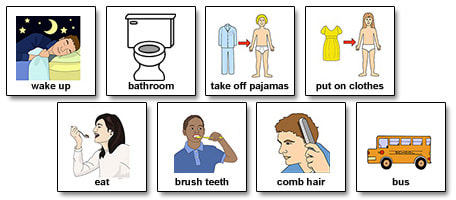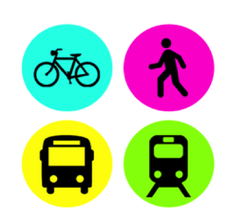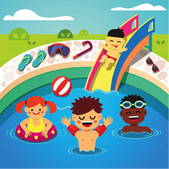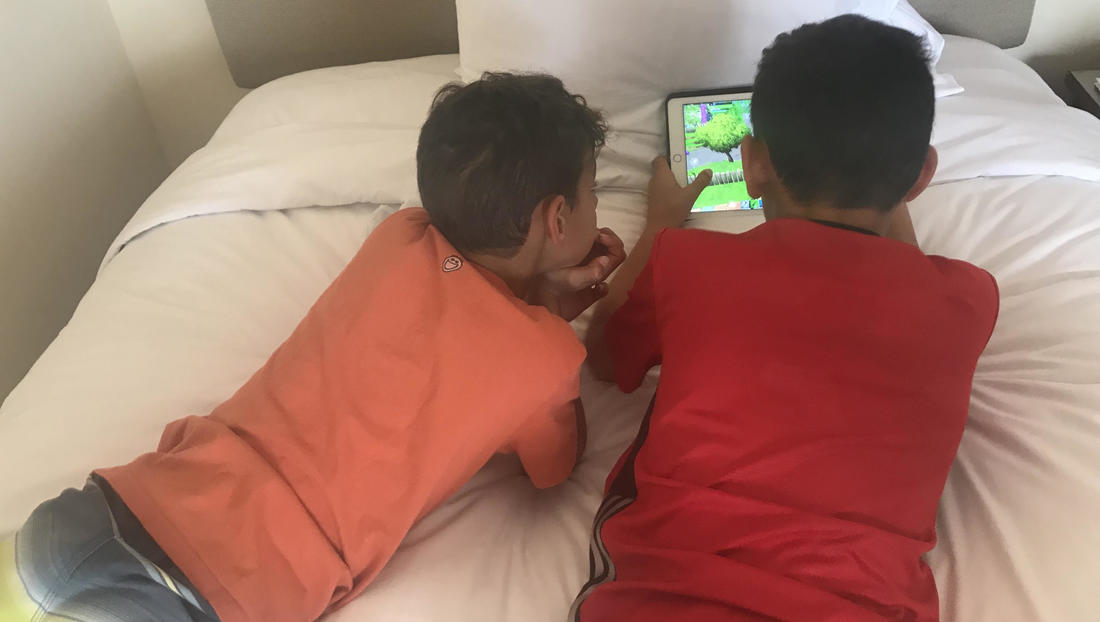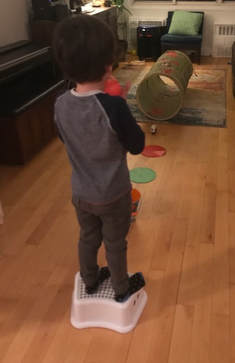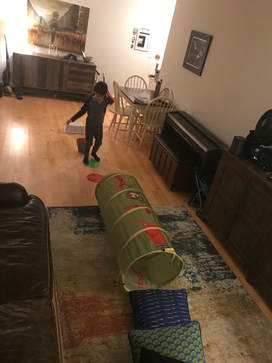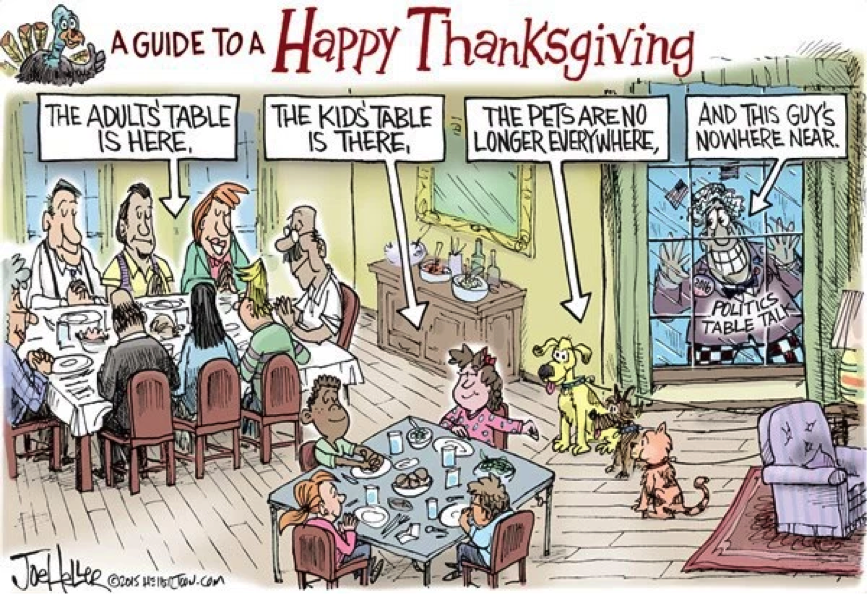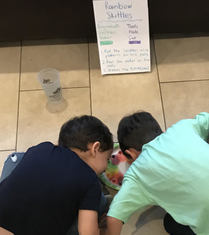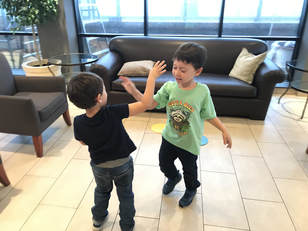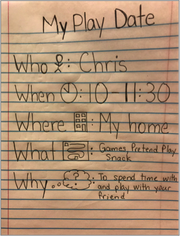|
Nili Geldwert, M.A. CCC-SLP and Julie Pike, M.A., CCC-SLP Make eye contact! - this is a popular phrase that many parents and educators use to get a child to look and focus on someone. There is good intention behind this and both parents and educators have the same goals when they give this directive. The goals are to have their child/student look at someone to gain information; look at someone because it is socially expected to when talking and listening; and to look at someone as a sign of respect (in American culture). However, for many individuals on the autism spectrum they find this to be physically uncomfortable and therefore counterintuitive to the goals of making eye contact. According to Jeanette Purkis, an individual on the autism spectrum, as well as an author and passionate advocate for individuals on the autism spectrum, “Eye contact makes me feel threatened, I may not look you in the eye but that doesn’t mean I’m not taking in what you are saying.” Research also supports that it is difficult for some people on the autism spectrum to have two sensory inputs work simultaneously, therefore making one input suffer. But, we cannot deny that eye contact is not important in our New York City culture and beyond. So….how do we address this, while still respecting our clients’ sensory needs? At Social Adventures NYC, we focus on teaching social communication strategies instead of discrete social skills trials. Our philosophy is based on dynamic and organic experiences and the associated positive and negative natural consequences. For example, when you are not attending to someone’s facial expression and/or body language, you miss valuable information from the speaker and might miss out on something fun. According to Professor Mehrabian’s research, he discovered the following communication model: 55% of communication is body language, 38% is tone of voice, and 7% is the actual, literal words spoken. Of course, every communication event is unique, so therefore this cannot blindly be applied, but it is important to acknowledge and to take a moment to think about the impact this has on your child. The best way to try to relate to this, is thinking about going to a foreign country and not understanding what eye contact means in that culture. You may take a few days to observe and feel a bit uncomfortable, but then quickly figure it out. In contrast, our clients need support in understanding what comes intuitively to us. Here are some ways in which we help our clients think with their eyes in therapy. We utilize specific language to highlight and encourage the use of thinking with their eyes to gain information and to communicate a message.
Other posts... December 2018 Nili Geldwert, M.A. CCC-SLP and Julie Pike, M.A., CCC-SLP It’s that time of year again…back to school! For many children this is an exciting time. They look forward to a new backpack, clothing, and school supplies; however, for many children with social communication challenges this creates a level of anxiety. Before we offer you strategies to help your child through this transition, we think it’s beneficial to understand why starting a new school year is so difficult, even for older kids who have had many years of experience. We have broken up a child’s challenges into two categories, macro and micro challenges. While this is not an exhaustive list, here are many of our clients’ concerns we have witnessed over the years. Macro: meeting new classmates, teachers and other staff members, adjusting to a new classroom environment and structures, possible new lunch time and table mates, navigating a new hallway or class location, playing with new recess playmates, adjusting to using a locker, possible arrival and dismissal routine changes. Micro: (these are more socially nuanced compared to the Macro list) getting to know the teachers’ personality, reading facial expressions and body language, getting to know new peers’ likes and dislikes, classroom rules, cliques, figuring out where you belong in a group, how to initiate conversation with peers, advocate for himself/herself, emailing teachers and peers, and office hour expectations. Below are some suggestions that could support your child’s transition into the new school year. Based on our experience, it is important to provide as much information to your child prior to the first day of school to alleviate the nerves. We suggest priming your child about 2 weeks prior to the first day of school. Schedule Start with looking at the school calendar for the month of the September and mark down the first day of school and any days off. You could then create a daily schedule with your child to include wake up time, morning routine, after school routine and bedtime. For some children that enjoy the concept of time, write down the specific time they have to complete each morning task. This will help them organize and take ownership of their responsibilities. For example, 7:00 wake-up, 7:15 get dressed, 7:25 breakfast, etc. Many websites, such as do2learn.com, have highly usable printable visual schedules - there is no need to reinvent the wheel. Using a timer, such as the Alexa device or a visual timer, will help to reduce the amount of times you need to remind your child to complete a task. We suggest trying out this schedule for a few days prior to school starting, especially if it varies from your current routine. Example of a morning schedule from do2learn.com: Visit Some schools might have already had you take a tour and meet the teachers. If your child’s school did not offer this opportunity we strongly recommended you advocate for your child to have the chance to visit the school before the first day. If this is not possible (or your child is interested in the school schedule and/ or layout of the school before the visit), we suggest you going on the school’s website to see what information is available. You could also request a map and class schedule sample. Another suggestion for a child that perseverates over specific concerns is to have him or her write down their questions or concerns in a notebook which will be answered at the end of each day. This will provide an outlet to express their thoughts and hopefully reduce the anxiety. For children who will be commuting to and from school via mass transit or walking, it is beneficial to try the route and transportation before the first day. For older kids, troubleshoot alternative routes in case there are transportation disruptions. Sensory Considerations Many children have sensitivities to different clothing materials so it’s important to try on new outfits/uniforms. The Target store last year launched a collection of sensory- friendly apparel and an adaptive collection, made for kids with physical disabilities.This could be an option if your child has any of these sensitives. We also recommend previewing new school gear, like a backpack, jacket and sneakers, ahead of the first day of school to ensure that your child will be comfortable. Summary This time of year is filled with a variety of feelings that will constantly change (for you and your child). Everyone may be excited, nervous, frustrated and frightened, to name a few. It is important to understand your child's feelings and try to problem solve their concerns to alleviate their worries. Having your child involved in this process will also give him or her confidence and autonomy which is very empowering for children and will help them start the school year off on the right foot. Other posts... August 2018 Nili Geldwert, M.A. CCC-SLP and Julie Pike, M.A., CCC-SLP Camp is right around the corner, and we often know that there could be a lot of anxiety built around going somewhere new for children with social communication challenges. We thought it would be helpful to provide a model of a social story(TM) and some guidelines to help you write one. A social story is a researched based tool that was created by Carol Grey. It could be used for children of all ages with varying language abilities. It provides general information as well as the social expectations of a new experience. Below is a sample of a generic social story that you could adapt to your child’s needs. We are providing the parent friendly version of the components used in a social story. Our pseudo child for this story is a 6 year old who attends an ICT classroom in a public school. He will be attending 92nd Street Y this summer for the first time. We used many clip art photos, but it is best to try to use real images. We want to emphasize that the goal is not to change a child’s behavior, but to provide them with the tools to understand a new, perhaps socially confusing experience. General Guidelines
Sample Social Story: Summer Camp at 92nd Street Y Children go to camp during the summer months. They go to play sports, participate in arts and crafts activities and meet new friends. This summer you will be going to camp at 92nd Street Y. You will be attending from June 26th to July 27th. The camp day starts at 8:30 and ends at 3:00pm. Mom or dad will drop you off and pick you up at the end of the day. Some children get to camp by taking a bus, subway, bike or walking. You will be walking and sometimes you will take a bus if the weather is raining or if we are running late. When you get to camp your two counselors, Michelle and Alex, will greet you. You will wait with them in the lobby until the other campers arrive. Everyday your counselors will tell you the schedule for that day. Every day you will swim, do arts and crafts and eat lunch. Some days you will play sports like soccer and kickball. ,Some activities will be new for you. Your counselors will explain any unfamiliar sports or activities. If you are still confused, use your words in a calm way to ask for additional information. It is sometimes helpful to watch a new activity before you participate. Some of the activities might not be your favorite. Try to remember that each one lasts about 30 minutes. After you have tried to participate and you still do not like it, you could use your words and calmly ask to sit and watch. Sometimes changes happen to the schedule. This could make some campers uncomfortable or frustrated. If this happens, you could take a few deep breaths or ask to take a break. You could also ask the counselor if she knows why the change happened. She will sometimes give you an answer and sometimes she won’t know why. You could remember that, “changes happen just like that, poof”. At camp you will meet new friends. It is helpful to find out the other children’s names. You could also ask them how old they are and where they go to school. The kids will want to learn about you too. At the start of camp, you might play getting to know you games and you might find people who have similar interests as you. The first week will be filled with new experiences and might make you feel nervous. It is okay to feel this way. Lots of kids will have the same feelings. Remember that you could use your words to ask for help. You could also ask to take a break in a quiet area. You could always talk to mom and dad when you come home from your camp day. As you continue to go to camp more, you will become more comfortable with the schedule, the counselors and the other campers. Other posts... April 2018 Nili Geldwert, M.A. CCC-SLP and Julie Pike, M.A., CCC-SLP Your child keeps coming home and talking about wanting to invite a friend over. How exciting! He really wants to get together with the friend, but doesn’t know what steps to take to make it happen. He is getting older and now is a great time to help guide them and make them feel confident in eventually doing this independently. Below are steps that you could follow to support your child in “hanging out.” Getting Digits Have your child give his friend his (if has his own cell phone) or your phone number. You could write down this information for them so he could pass it along to his friend at school. Remind your child to also ask for his friend’s information. If your child needs help with this step, you could get the phone number for them but try to encourage your child to do it himself. Role play with your child what he could say when he calls his friend. You could have him make the phone call on speaker so you could ensure all the important details are discussed. Follow-up with the other parent to confirm. Hanging Out Guidelines
Activities
Post Playdate After the playdate has finished, take some time to reflect on what worked and what didn’t work. Your child might need some down time, but later on ask your child how he thought it went. You could help to recall some of activities and how he felt about them. If the kids had a conflict you could discuss how it got resolved. Often times kids focus on the negative, so try to wrap up on a positive experience. If your child really worked hard in being a host, commend them for a job well done - it takes a lot of social thinking and courage to have a friend over!
|
Other posts... |
Nili Geldwert, M.A. CCC-SLP and Julie Pike, M.A., CCC-SLP
Thanksgiving can be a fun and festive time but it can also be stressful and anxiety producing. We hope you find the tips below useful in creating more joy and less stress around the holiday.
1. Prepare your child for what to expect in advance of the day. You can make a visual schedule answering important information such as the time of the event, the place, who will be there (family/friends), and the reason for the gathering.
2. As you know children can be picky eaters and this could be even more challenging during this holiday. You could set up a mock Thanksgiving meal and try out some of the new foods. You could also have some of their favorite food items with you just in case they don’t like anything. Practice with your child how to politely decline unpreferred food.
3. Children with sensory sensitivities to noise and crowds may benefit from arriving a little earlier than the start time to acclimate to the noise and people.
4. Locate the bathroom, playroom, and a quiet area when you arrive.
5. If you are at someone else’s home, this new environment can be overwhelming. Finding a quiet place for your child to go to for a break can help to calm them if it becomes over stimulating. You can discuss this with the host in advance if you do not feel comfortable walking through their home! Also, having preferred toys and/or calming items can be helpful to soothe and comfort your child.
6. Interacting with your relatives can sometimes require some social savviness. Some children don’t like engaging with unfamiliar relatives. If your child is young, you can advocate for them and guide the conversation. If your child is ready for role playing, you can role play these interactions and review with them the most common questions such as “what school do you go to?” or “how old are you?”, as well as including how to greet and gracefully end the conversation. If your child is on the older side or is interested in politics, try to remind them about the expectation of talking to others about taboo topics such as politics, race, religion, etc.
7. Remember to check in with your child throughout the event, as many children might not initially appear overwhelmed or communicate their feelings, but then behaviors change in an instant. Depending on your child, using check-ins could be helpful to gauge how they are coping. For example, you can establish a gesture (e.g., thumbs up/down) or a code word to use as a gauge. Check-ins should be approximately every 15 minutes.
Using the above strategies can help to maximize your child’s chance for a pleasant and comfortable holiday celebration. Remember to acknowledge your child’s efforts by telling them what went well and how proud you are! Have a Happy and Healthy Thanksgiving!
2. As you know children can be picky eaters and this could be even more challenging during this holiday. You could set up a mock Thanksgiving meal and try out some of the new foods. You could also have some of their favorite food items with you just in case they don’t like anything. Practice with your child how to politely decline unpreferred food.
3. Children with sensory sensitivities to noise and crowds may benefit from arriving a little earlier than the start time to acclimate to the noise and people.
4. Locate the bathroom, playroom, and a quiet area when you arrive.
5. If you are at someone else’s home, this new environment can be overwhelming. Finding a quiet place for your child to go to for a break can help to calm them if it becomes over stimulating. You can discuss this with the host in advance if you do not feel comfortable walking through their home! Also, having preferred toys and/or calming items can be helpful to soothe and comfort your child.
6. Interacting with your relatives can sometimes require some social savviness. Some children don’t like engaging with unfamiliar relatives. If your child is young, you can advocate for them and guide the conversation. If your child is ready for role playing, you can role play these interactions and review with them the most common questions such as “what school do you go to?” or “how old are you?”, as well as including how to greet and gracefully end the conversation. If your child is on the older side or is interested in politics, try to remind them about the expectation of talking to others about taboo topics such as politics, race, religion, etc.
7. Remember to check in with your child throughout the event, as many children might not initially appear overwhelmed or communicate their feelings, but then behaviors change in an instant. Depending on your child, using check-ins could be helpful to gauge how they are coping. For example, you can establish a gesture (e.g., thumbs up/down) or a code word to use as a gauge. Check-ins should be approximately every 15 minutes.
Using the above strategies can help to maximize your child’s chance for a pleasant and comfortable holiday celebration. Remember to acknowledge your child’s efforts by telling them what went well and how proud you are! Have a Happy and Healthy Thanksgiving!
Other Posts ...
Nili Geldwert, M.A. CCC-SLP and Julie Pike, M.A., CCC-SLP
Yay! Your child wants a playdate. Where do you begin?
First, find a calm time in which you know that you have your child's attention and sit down with them. You know your child best, so you may want limit the amount of information you provide if your child gets anxious when given a lot of information to process. Some children need a day or up to a week to process and prepare for a play date, while others may become more anxious when given any advance notice. It's important to allow your child processing time when giving new information and asking them questions. Encourage them to ask you questions about the play date.
PRE- PLAYDATE STRATEGIES
1. Choose a time in which your child is well rested and at their best. This is usually on weekend mornings and right after school if their schedule allows.
2. Review the big picture with your child: Who is coming? What activities will be offered? When is their playmate coming? Where will they play? How long will they stay? See the picture below highlighting how you could provide this in a visual way for your child. Notice all you need is a pen and paper. Keep it simple and clear.
First, find a calm time in which you know that you have your child's attention and sit down with them. You know your child best, so you may want limit the amount of information you provide if your child gets anxious when given a lot of information to process. Some children need a day or up to a week to process and prepare for a play date, while others may become more anxious when given any advance notice. It's important to allow your child processing time when giving new information and asking them questions. Encourage them to ask you questions about the play date.
PRE- PLAYDATE STRATEGIES
1. Choose a time in which your child is well rested and at their best. This is usually on weekend mornings and right after school if their schedule allows.
2. Review the big picture with your child: Who is coming? What activities will be offered? When is their playmate coming? Where will they play? How long will they stay? See the picture below highlighting how you could provide this in a visual way for your child. Notice all you need is a pen and paper. Keep it simple and clear.
3. Use a calendar to mark when the play date will occur.
4. A play date should last approximately 1-2 hours. It's just enough time for them to warm up to each other, play and end on a good note!
5. Favorite toys are usually difficult for a child to share. It might be helpful to remove these toys and put them away during the playdate. If your child is ready to make this decision with you, take their lead.
6. Develop and write down a simple list of house rules to review with the children. For example: use an indoor voice, no running, use your words to ask for something, etc.
7. Plan a joint structured activity, such as a science experiment or cooking. Pinterest has great, simple and engaging activities.
8. Plan an activity where the kids can share the materials such as building blocks or pretend kitchen toys. If your child is ok with winning or losing, a board game provides a structured activity.
9. Have your child decide on several snack options for them and their friend. Snack is a great grounding activity if the kids start behaving like “Max from Where the Wild Things Are”.
PLAYDATE STRATEGIES
1. Just before the friend enters, role-play what your child should say when they arrive. For example, "Hi! Come on in. Can you please take your shoes off?"
2. Review the rules for your house that you have written down.
3. Write down a simple schedule for the playdate based on the pre-playdate planning.
And off they go...
Ok parent, here are some tips for you to follow during the playdate! A playdate can be messy even with all the pre-playdate planning.
1. Make yourself available but don't hover. Depending on your child and the playmate this means that you are in the same room as them but are doing something else (reading, chatting with the other caregiver).
2. If a conflict arises and no one is in danger, let the kids try to resolve it on their own. If they need support, you can remind them of the playdate rules or offer suggestions.
3. Provide a warning that it's almost time for the next activity. Five minutes should be suffice but you can do this earlier than planned if you notice "Max the Wild Thing" coming out.
Playdates can go on without a hitch. Sometimes they are messy and sometimes a mixture of both. All of this is ok. When things have settled down, take some time to reflect as to what worked really well for your child and what needs to be tweaked. Congratulations, now you can plan your next playdate!
4. A play date should last approximately 1-2 hours. It's just enough time for them to warm up to each other, play and end on a good note!
5. Favorite toys are usually difficult for a child to share. It might be helpful to remove these toys and put them away during the playdate. If your child is ready to make this decision with you, take their lead.
6. Develop and write down a simple list of house rules to review with the children. For example: use an indoor voice, no running, use your words to ask for something, etc.
7. Plan a joint structured activity, such as a science experiment or cooking. Pinterest has great, simple and engaging activities.
8. Plan an activity where the kids can share the materials such as building blocks or pretend kitchen toys. If your child is ok with winning or losing, a board game provides a structured activity.
9. Have your child decide on several snack options for them and their friend. Snack is a great grounding activity if the kids start behaving like “Max from Where the Wild Things Are”.
PLAYDATE STRATEGIES
1. Just before the friend enters, role-play what your child should say when they arrive. For example, "Hi! Come on in. Can you please take your shoes off?"
2. Review the rules for your house that you have written down.
3. Write down a simple schedule for the playdate based on the pre-playdate planning.
And off they go...
Ok parent, here are some tips for you to follow during the playdate! A playdate can be messy even with all the pre-playdate planning.
1. Make yourself available but don't hover. Depending on your child and the playmate this means that you are in the same room as them but are doing something else (reading, chatting with the other caregiver).
2. If a conflict arises and no one is in danger, let the kids try to resolve it on their own. If they need support, you can remind them of the playdate rules or offer suggestions.
3. Provide a warning that it's almost time for the next activity. Five minutes should be suffice but you can do this earlier than planned if you notice "Max the Wild Thing" coming out.
Playdates can go on without a hitch. Sometimes they are messy and sometimes a mixture of both. All of this is ok. When things have settled down, take some time to reflect as to what worked really well for your child and what needs to be tweaked. Congratulations, now you can plan your next playdate!
Other Posts...
Nili Geldwert, M.A. CCC-SLP and Julie Pike, M.A., CCC-SLP
Are you planning on taking an adventure, big or small, with your child? Perhaps you want to visit the new ice-cream store down the block or the zoo. We at Social Adventures NYC understand the needs of children who have autism and/or those that have social communication challenges during these outings. We've put together some helpful strategies that can make the experience more pleasurable for your child and for you. Our social communication support strategies are divided into three categories: pre-adventure, adventure, and post-adventure.
PRE-ADVENTURE
Take a moment and think about how you prepare yourself to go to a new place. Now that we have technology at our fingertips, we Google the destination, look at the website, check the location, figure out how we’re going to get there, and take note on what to expect. This process is called priming; we get ourselves ready for what to expect. Children with social communication challenges need similar priming. Before going on an adventure, a child might feel nervous or apprehensive. He or she may not be able to express their feelings but might show it in their behaviors. Since children usually cannot prime themselves, parents can do that for them.
Things to keep in mind:
Pre-Adventure Priming tips:
ADVENTURE
POST ADVENTURE
Reflection time is a dedicated time to debrief on an experience or set of experiences. This time is highly valuable and helps to solidify the experience and the emotions for the child. Here a few strategies to facilitate reflection time:
PRE-ADVENTURE
Take a moment and think about how you prepare yourself to go to a new place. Now that we have technology at our fingertips, we Google the destination, look at the website, check the location, figure out how we’re going to get there, and take note on what to expect. This process is called priming; we get ourselves ready for what to expect. Children with social communication challenges need similar priming. Before going on an adventure, a child might feel nervous or apprehensive. He or she may not be able to express their feelings but might show it in their behaviors. Since children usually cannot prime themselves, parents can do that for them.
Things to keep in mind:
- You know your child best, so you might want to try to limit the amount of information you provide if your child gets anxious when given a lot of information to process. Some children need a day or up to a week to process and prepare for a new adventure, while others may become more anxious when given any advance notice. Sometimes using a calendar to countdown the days is helpful.
- It's important to allow your child processing time when giving new information and asking him or her questions (45 seconds). Encourage them to ask you questions about the adventure.
Pre-Adventure Priming tips:
- Look at the website or online reviews/photos for the location where you’ll be headed to with your child. Any visual representation that you can identify provides a visual support which helps your child begin to see themselves in the place. Research things about the specific place, for example, where is it located, what are some things that the child will likely see or do, who are some people that he/she might meet.
- Write or verbally provide a brief schedule of the time and activities. This often grounds and organizes children and gives them a framework of what to expect. Where possible, try to add in some form of flexibility - adding in some buffer with regards to potential changes in timing (e.g. train delays affecting arrival, departure) and general expectations (e.g. waiting time for activities or who may or may not be attending a birthday party).
- Think about potential problems that could arise and possible solutions. This could include proactively identifying explanations, distractions, or other coping mechanisms for situations such as waiting on a long line or a negative reaction to favorite ride or exhibit being closed.
- Role play possible scenarios and specific language with your child that could be used to express his/her ideas or feelings. For example, if you are going to an ice-cream store and it is very crowded, you could model with your child what he or she could say. In this example, some possible phrases that could be used include: This is too crowded/noisy. Can I wait at a table, while you get the ice cream? Let’s come back later. Can you please give me my ____________ (security or calming tool).
- Let your child know that if he or she feels overwhelmed, they can take a break. It’s highly important for children to constantly be reminded that they (almost) always have the option of taking a break - either with an adult (e.g. walk outside the room or facility) or potentially on their own (e.g. to another part of the room).
- If it's a new place you might want to consider only staying for a brief time, depending on your child’s response to the experience. If this is the case, you can try to increase the time on your next visit.
ADVENTURE
- When you arrive at your destination, point out important visuals that might be posted. This could be a list of amusement park rides or a map of the museum. You could also point out signs such as the bathroom or a list of ice-cream flavors. If there are any rules listed, take the time to read them over with your child and make sure they are clear and concrete.
- Discuss the “plan” with your child - whether it be your plan (family outing) or someone else’s (birthday party), it’s important to help to appropriately set the child’s expectations. It can be helpful to make a quick schedule, on your phone/tablet or on a piece of paper (if you haven't done so during the priming stage), that can be referenced throughout your adventure. The list may include quiet breaks, bathroom visits, gift store visit and meal times. See below for a sample plan for a visit to the zoo:
- Enter the park and buy tickets
- Look at a map of the animals and any other attractions
- Visit the lions
- Visit the monkeys
- Bathroom break
- Lunch
- Ride the Monorail
- Quiet break
- Animal visit: your child’s name’s choice
- Gift shop
- Bathroom break
- Home
- As you and your child are enjoying the experience, highlight or make comments connecting your child’s feeling to the experience. Many children that have autism or social communication challenges struggle with remembering how they felt in a given moment. A child will often remember the facts but not the emotion surrounding the experience. By highlighting the emotion, you can help to make your child more aware of his or her feelings. For example, you could say "I can tell you are having fun riding the monorail. You have a big smile on your face and are pointing at all the animals you see!”
- If you encounter a problem, such as a long line, you can use positive self-talk. Self-talk is a way in which you talk aloud about possible strategies you would try when encountering a problem. For example, you could say "This line is really long. It's hard to wait but I know the monorail ride is going to be so much fun. I am going to take some deep breaths as I wait so my body stays calm. I might squeeze my squishy ball too. I'm noticing the line is moving. It's almost our turn."
- A quick and (hopefully) easy thing you can do to help your child remember this adventure and how it made him or her feel is by taking pictures or videos. When taking pictures/videos make sure to include your child's face. If your child does not enjoy being photographed or videoed, you could encourage him/her to be the photographer or you could take pictures of his/her favorite part. Later on you could put captions on them or replay them and review the experience. Photos are also great to share with your child’s classroom teacher to help them share about his/her experiences outside of the classroom.
POST ADVENTURE
Reflection time is a dedicated time to debrief on an experience or set of experiences. This time is highly valuable and helps to solidify the experience and the emotions for the child. Here a few strategies to facilitate reflection time:
- Make a quick slideshow on your phone of the day’s adventure or review pictures and/or any souvenirs that you collected. It is fun to have a photo album of all the adventures, big or small, for your child to review.
- If a problem arises and it was solved successfully, review the problem and solution with your child. It can be helpful to ask your child how he or she initially felt, note how the problem was solved and remember how he/she felt afterwards.
Other Posts...
Archives
December 2018
August 2018
June 2018
April 2018
January 2018
November 2017
October 2017
September 2017


